Dawoud Bey
“An American Project”
Whitney Museum of American Art
New York, 99 Gansevoort Street
Since the mid-1970s, Dawoud Bey (b. 1953) has worked to expand upon what photography can and should be. Insisting that it is an ethical practice requiring collaboration with his subjects, he creates poignant meditations on visibility, power, and race. Bey chronicles communities and histories that have been largely underrepresented or even unseen, and his work lends renewed urgency to an enduring conversation about what it means to represent America with a camera.
Dawoud Bey, A Young Man Resting on an Exercise Bike, Amityville, NY, 1988. Pigmented inkjet print (printed 2019), 30 × 40 in. (76.2 × 101.6 cm). Collection of the artist; courtesy Sean Kelly Gallery, New York; Stephen Daiter Gallery, Chicago; and Rena Bransten Gallery, San Francisco. © Dawoud Bey
Dawoud Bey, A Man at Fulton Street and Cambridge Place, Brooklyn, NY, 1988. Pigmented inkjet print (printed 2019), 30 × 40 in. (76.2 × 101.6 cm). Collection of the artist; courtesy Sean Kelly Gallery, New York; Stephen Daiter Gallery, Chicago; and Rena Bransten Gallery, San Francisco. © Dawoud Bey
Spanning from his earliest street portraits in Harlem to his most recent series imagining an escape from slavery on the Underground Railroad, Dawoud Bey: An American Project attests to the artist’s profound engagement with the Black subject. He is deeply committed to the craft of photography, drawing on the medium's specific tools, processes, and materials to amplify the formal, aesthetic, and conceptual goals of each body of work. Bey views photography not only as a form of personal expression but as an act of political responsibility, emphasizing the necessary and ongoing work of artists and institutions to break down obstacles to access, convene communities, and open dialogues.








